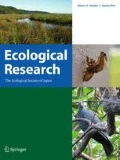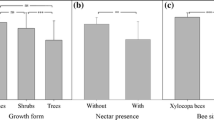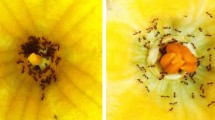The Asian weaver ant, Oecophylla smaragdina, is known to have outstanding predatory power. This ant can protect the host plants from attacks of phytophagous insects and therefore has been used for biological control in the tropics. We present evidence for a possible negative effect of Oecophylla on the performance of host plants. Our observation in a fruit orchard of rambutan in Sumatra suggested that the presence of Oecohylla nests on the trees statistically significantly lowered the flower-visiting rate of flying insects, involving the major pollinator Trigona minangkabau. The visiting rate of Oecophylla workers to each flower shoot of rambutan significantly negatively correlated with the visiting rate of flying insects. Empirical evidence of such an inhibitory effect on flower-visiting of pollinators cased by aggressive ants has been scarce so far.
Similar content being viewed by others
References
Azuma N., Kikuchi T., Ogata K., Higashi S. (2002) Molecular phylogeny among local populations of weaver ant Oecophylla smaragdina. Zoological Science 19: 1321–1328.
Beattie A. J. (1985) The Evolutionary Ecology of Ant-Plant Mutualisms. Cambridge University Press, London.
Beattie A. J., Turnbull C. L., Hough T., Jobson S., Knox R. B. (1985) The vulnerability of pollen and fungal spores to ant secretions: evidence and some evolutionary implications. American Journal of Botany 72: 606–614.
Bernardello G., Anderson G. J., Stuessy T. F., Crawford D. J. (2001) A survey of floral traits, breeding systems, floral visitors, and pollination systems of angiosperms of the Juan Fernandez Islands (Chile). Botanical Review 67: 255–308.
Birkhead T. (2000) Promiscuity: an Evolutionary History of Sperm Competition. Faber and Fabor, London.
Bluthgen N., Gebauer G., Fiedler K. (2003) Disentangling a rainforest food web using stable isotopes: dietary diversity in a species-rich ant community. Oecologia 137: 426–435.
Bronstein J. L. (1988) Predators of fig wasps. Biotropica 20: 215–219.
Djieto-Lordon C. & Dejean A. (1999) Tropical arboreal ant mosaics: innate attraction and imprinting determine nest site selection in dominant ants. Behavioral Ecology and Sociobiology 45: 219–225.
Fiedler K. (1991) A systematic, evolutionary, and ecological implications of myrmecophily within the Lycaenidae (Insecta: Lepidopera: Papilionoidea). Bonner Zoological Monograph. 31: 1–210.
Fleming P. A. & Nicolson S. W. (2003) Arthropod fauna of mammal-pollinated Protea humiflora: ants as an attractant for insectivore pollinators? African Entomology 11: 9–14.
Galen C. & Butchart B. (2003) Ants in your plants: effects of nectar-thieves on pollen fertility and seed-siring capacity in the alpine wildflower, Polemonium viscosum. Oikos 101: 521–528.
Hölldobler B. (1983) Territorial behaviour in the green ant (Oecophylla smaragdina). Biotropica 15: 214–250.
Hölldobler B. & Wilson E. O. (1978) The multiple recruitment systems of the African weaver ant Oecophylla longinoda (Latreille). (Hymenoptera: Formicidae). Behavioral Ecology and Sociobiology 3: 19–60.
Hölldobler B. & Wilson E. O. (1990) The Ants. Belknap Press, Harvard University Press, Cambridge, MA.
Inoue T., Salmah S., Abbas I., Yusuf. E. (1985) Foraging behavior of individual workers and foraging dynamics of colonies of three Sumatran stingless bees. Researches on Population Ecology 27: 373–392.
Itioka T., Nomura M., Inui Y., Itino T., Inoue T. (2000) Difference in intensity of ant defense among three species of Macaranga Meyrmecophytes in a Southeast Asian dipterocarp forest. Biotropica 32: 318–326.
Janzen D. H. (1966) Coevolution of mutualism between ants and acacias in Central America. Evolution 20: 249–275.
Kalshoven L. G. E. (1981) Pests of Crops in Indonesia, P. T. Ichtiar Baru –Van Hoeve, Jakarta.
Kawakita A. & Kato M. (2002) Floral biology and unique pollination system of root holoparasites Balanophora kuroiwai, and B. tobiracola. American Journal of Botany 89: 1164–1170.
Konishi M. & Itô Y. (1973) Early entomology in east Asia. In: History of Entomology (eds Smith, R. F., Mittler, T. E. & Smith, C. N.), pp. 1–20. Annual Review Inc, Palo Alto, CA.
McKey D., Davidson W., Gray H. (1993) Ant-plant symbioses in Africa and the neotropics: history, biogeography, and diversity. In: Biological Relationships Between Africa and South America (ed. Goldblat, P.), pp. 568–606. Yale University Press, New Haven, Connecticut.
Peng R. K., Christian K., Gibb K. (1997) Control threshold analysis for the tea mosquito bug, Helopeltis pernicialis (Hemiptera: Miridae) and preliminary results concerning the efficiency of control by the green ant, Oecpphylla smaragdina (Hymenoptera; Formicidae) in northern Australia. International Journal of Pest Management 43: 233–237.
Peng R. K., Christian K., Gibb K. (1999) The effect of colony isolation of the predacious ant, Oecophylla smaragdina (F.) (Hymenoptera; Formicidae), on protection of cashew plantations from insect pests. International Journal of Pest Management 45: 189–194.
Pierce N. E. (1989) Butterfly-ant mutualisms. In: Toward a More Exact Ecology (eds Grubb, P. J. & Whittaker, J. B.), pp. 299–329. Blackwell Science Publications, Oxford.
Raju A. J. S. & Ezradanam V. (2002) Pollination ecology and fruiting behaviour in a monoecious species, Jatropha curcas L. (Euphorbiaceae). Current Science 83: 1395–1398.
Schatz B. & Hossaert-McKey M. (2003) Interctions of the ant Crematogaster scutellaris with the fig/fig wasp mutualism. Ecological Entomology 28: 359–268.
Tobin J. E. (1991) A neotropical, rainforest canopy, ant community: some ecological considerations. In: Ant–Plant Interactions (eds Huxley, C. R. & Cutler, D. F.), pp. 536–538. Oxford University Press, Oxford.
Van Mele P. & Cuc N. T. T. (2000) Evolution and status of Oecophylla smaragdina (Fabricius) as a pest control agent in citrus in the Mekong Delta, Vietnam. International Journal of Pest Management 46: 295–301.
Way M. J. & Khoo K. C. (1992) Role of ants in pest management. Annual Review of Entomology 37: 479–503.
Willmer P. G. & Stone G. N. (1997) How aggressive ant-guards assist seed-set in Acacia flowers. Nature 388: 165–167.
Author information
Authors and Affiliations
Corresponding author
About this article
Cite this article
TSUJI, K., HASYIM, A., Harlion et al. Asian weaver ants, Oecophylla smaragdina, and their repelling of pollinators. Ecol Res 19, 669–673 (2004). https://doi.org/10.1111/j.1440-1703.2004.00682.x
Received:
Accepted:
Issue Date:
DOI: https://doi.org/10.1111/j.1440-1703.2004.00682.x




